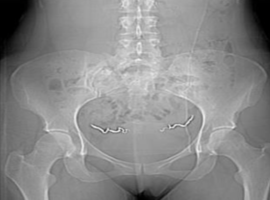Uterine arteriovenous malformation (AVM) is a rare gynecologic condition involving abnormal communication between myometrial arteries and veins. AVMs can be congenital or acquired, acquired AVMs often being a result of uterine instrumentation. Other causes of acquired AVMs include Complications of prior pregnancies, cesarean scar pregnancy, uterine infection, gestational trophoblastic disease (GTN) or gynecological malignancies.
Patients with uterine AVMs typically present with episodes of sudden heavy bleeding and can often lead to life-threatening hemorrhage. Moreover, the associated vaginal bleeding is often refractory to standard therapy. Therefore, proper diagnosis and treatment is critical.
Diagnosis is centered around imaging modalities such as computed tomography (CT), magnetic resonance imaging (MRI), ultrasound, and angiography. As transvaginal ultrasound is the imaging modality of choice in gynecology, diagnosis is often based on ultrasonographic evidence of hypoechoic areas in the myometrium with vascular flow. Features may be similar to other differentials including retained products of conception (POCs), GTN and hemangioma. Angiography can further be used to assess size and identify feeding vessels while a CT or MRI can help evaluate for adjacent organ involvement.
Treatment depends on hemodynamic stability of the patient and, more recently, desired future fertility. There have been case reports of successful treatment with conservative or medical management, uterine artery embolization (UAE), or laparoscopic coagulation for those desiring fertility preservation. Otherwise, hysterectomy is recommended.
This case describes the progression of a patient with persistent vaginal bleeding in the setting of a missed abortion, possibly a cesarean scar pregnancy, after failed medical then surgical intervention, found to have a delayed diagnosis of acquired uterine AVM. The purpose of this case report is to highlight the importance of considering the differential of AVMs based on ultrasonographic evidence leading to proper diagnosis, management, and overall patient care.


